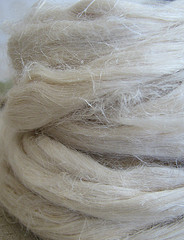
A plant that’s been around for ages could be the answer to our destructive addiction — to oil and timber. No, we’re not talking about marijuana — this is industrial hemp, a strain of the species Cannabis sativa that has too little of the active ingredient tetra hydra cannabinol (THC) to produce a high. The United Nations has declared 2009 as the International Year of Natural Fibers, and many believe that hemp is the answer to this call. Here are a few reasons why:
- Growing hemp is agriculturally responsible. Industrial hemp is grown in dense quantities, which means much less space is required to yield the same amount of product. Specifically, one acre of hemp yields four times the amount of fiber as one acre of trees. Furthermore, industrial hemp does not require the use of chemical herbicides, pesticides, or defoliants. The long, fiber-rich stalk and canopy of leaves that are characteristic of this strain allow little sunlight to reach the ground and nourish invading weeds. Finally, hemp has a short growing season of 100-120 days, thus it is a renewable resource and can be easily re-grown if something happens to the crop. Therefore, growing hemp requires less money to be spent on space and cultivation, and its natural immunity to weeds means that fewer chemicals will be sprayed into the environment.
- Eating hemp is nutritionally responsible. With an 81 percent content of polyunsaturated essential fatty acids, hemp oil is the richest known source of these important fats that our bodies need but cannot produce. Among other things, these acids help reduce cholesterol. It also contains a 3:1 ratio of Omega 6 to Omega 3, which is the optimum ratio of these fatty acids for human consumption. In addition, one serving of hemp seeds contains 25% daily value of protein. Therefore, the nutrients found in these fruits of the cannabis can actually reduce health problems in the consumers.
- Using hemp products is economically responsible. Hemp can be used to make high quality paper that lasts longer than wood-based paper and does not yellow. This paper can also be recycled several more times than wood-based paper. In production, hemp is pulped and bleached more easily than wood, which means that the chemicals involved are much weaker and much less harsh on the environment. Hemp can also be used for textiles. Sails, canvas, rope, and many other fibrous products used to be made from hemp. Clothes made from hemp are much more durable, absorbent, and mildew-resistant than those made from cotton. In production, hemp requires much less hydration than cotton crops. In addition, about half of the world’s pesticides are sprayed on cotton. This means a lot of money is being spent to maintain these crops and a lot of chemicals are being pumped into ecosystems while water is being pumped out. Therefore, hemp products are more cost-efficient because they last longer and cost less to produce.
So why not hemp? For at least 12,000 years, this plant was cultivated to produce paper, food, textiles, medicines, and oil. Until the Marijuana Tax Act of 1937, where all strains of Cannabis sativa were lumped into the taboo category of “marijuana,” hemp was widely grown, harvested, and used to make products throughout North America. Henry Ford experimented with hemp to build car bodies. Rudolph Diesel initially designed his engine to run on hemp oil. Paints, resins, and varnishes used to contain hemp oil. Altogether, this plant can be used in over 25,000 products. It is renewable, and is relatively benign to the environment.
So, if you’re looking for some new clothes, some stationary, or a healthy snack, go green — hemp is green.

